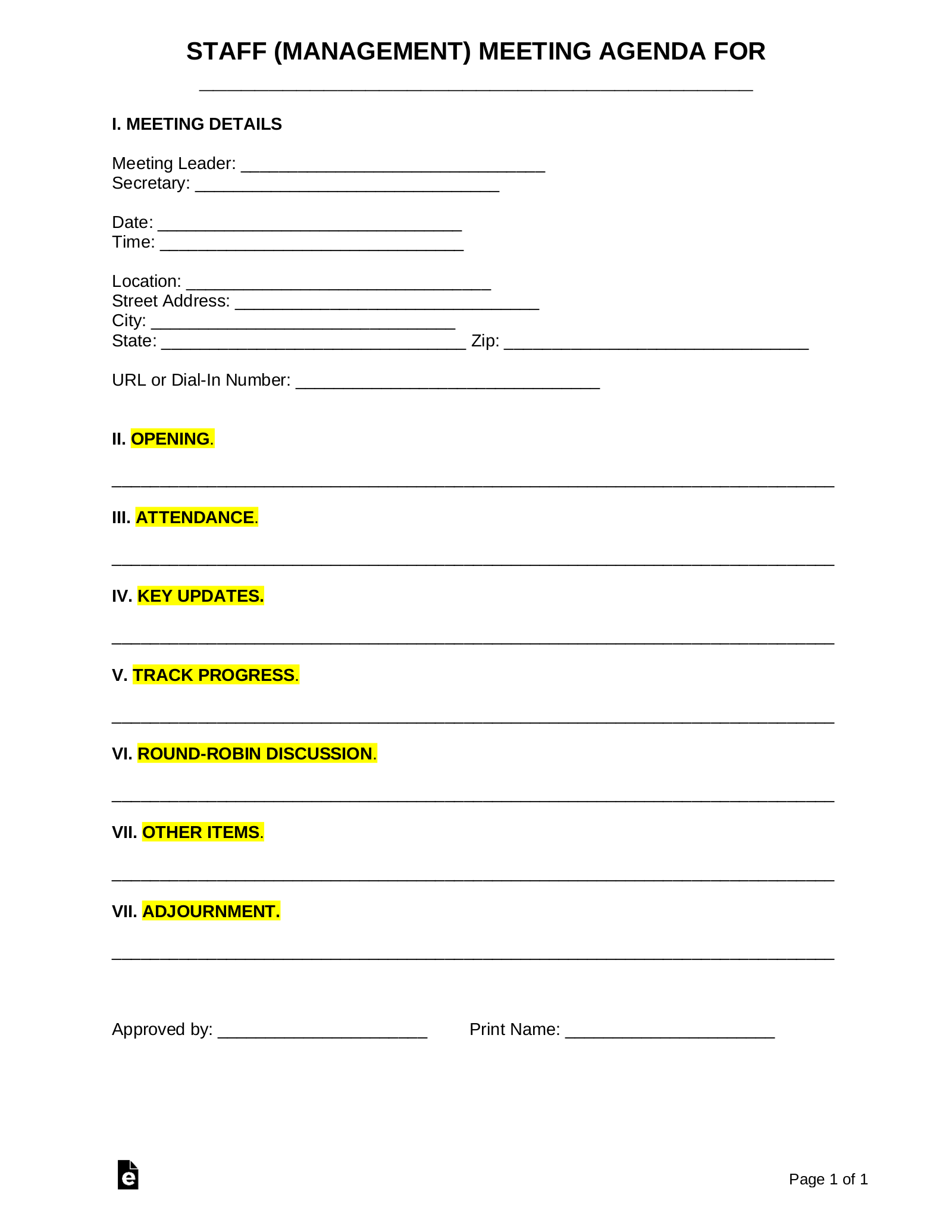Updated August 08, 2023
A staff (management) meeting agenda serves as a reference for all items of discussion in an upcoming management staff meeting. Those in leadership positions usually convene on a recurring basis to address metrics, company-specific progress, and essential updates. Accompanying the meeting with an agenda will ensure the flow of discussion while keeping all staff members on track throughout the entirety of said meeting. Due to the ever-changing circumstances that arise in the workplace, management meetings with proper agendas will allow managers to re-focus objectives as well as tackle issues before they escalate or become crippling to the business/organization.
Table of Contents |
Formatting (9 parts)
The formatting of a staff (management) meeting agenda will largely vary depending on the nature of the business or organization. However, the following is a general guideline that adheres to the common items discussed at such managerial meetings. Items can be altered or even added at the discretion of the individual tasked with creating the agenda.
I. Meeting Details
The meeting leader or organizer shall include all basic meeting details on the agenda, such as date, time, and location. A dial-in number or URL can be added if the meeting will be held online through a video-conferencing application (Zoom, Skype, Teams, and the like).
II. Opening
The opening item acts as a formal introduction to the meeting in general and its primary purposes. Copies of the agenda may be distributed to attendees at this time. Commonly at around five to ten minutes, this item also allows for a grace period if any staffers are running late.
If necessary, the person in charge of meeting minutes can officially call the meeting into order upon the start time or after the grace period for late arrivals.
III. Take Attendance
All attendees and absentees of the meeting can be recorded after going through a standard roll call. Those present and absent can be listed by name on the agenda.
IV. Key Updates
All notable updates or announcements that have come to light since the previous meeting can be communicated during this allocated time on the docket. These new reports are typically addressed first in order to later open the floor for discussion among attendees.
V. Track Progress
Tracking progress is a common reason for management convening regularly. Here, metrics can be measured in order to determine if the goals of the company/organization are on track towards being met. If the progress is straying away from planned goals, managers can utilize this time to discuss ways in which to improve or re-focus their priorities.
VI. Round-Robin Discussion
It is crucial to open the floor for updates, questions, and related comments or concerns; this is particularly effective for companies/organizations that are divided into departments or branches. A commonly used yet practical way to do this involves each attendee chiming in with their input on the matters in question through a roundtable-like forum. This is often referred to as a “round-robin” or “roundtable” discussion.
What’s more, having this item on the agenda will encourage attendees to reserve their questions, updates, and concerns until the allocated time for an open discussion.
VII. Vote on Resolutions
Many organizations and, sometimes, businesses resolve managerial matters by majority votes. If this is the case, this item can be included on the agenda to settle resolutions on issues that must be urgently addressed.
VIII. Other Items & Conclusion
Any matters that went undiscussed may be reserved for this section of the agenda.
Meeting leaders/organizers often use this closing item to assign upcoming tasks or detail the next steps. Ending with a call to action can resonate with attendees and compel them to initiate those tasks upon finalizing the meeting.
IX. Adjournment
Lastly, the manager in charge will conclude the meeting when all items have been discussed or upon the meeting’s set end-time. If applicable, the secretary or an authorized individual can approve meeting minutes upon adjournment.
Sample – Staff Meeting Agenda
Download: PDF, MS Word, OpenDocument



